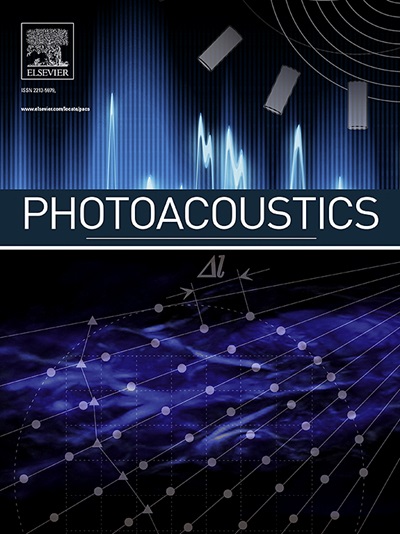Wavelength-time-division multiplexed fiber-optic sensor array for wide-field photoacoustic microscopy
IF 7.1
1区 医学
Q1 ENGINEERING, BIOMEDICAL
引用次数: 0
Abstract
Photoacoustic microscopy (PAM) faces a fundamental trade-off between detection sensitivity and field of view (FOV). While optical ultrasound sensors offer high-sensitivity unfocused detection, implementing multichannel detection remains challenging. Here, we present a wavelength-time-division multiplexed (WTDM) fiber-optic sensor array that assigns distinct wavelengths to individual sensors and employs varying-length delay fibers for temporal separation, enabling efficient multichannel detection through a single photodetector. Using a 4-element sensor array, we achieved an expanded FOV of 5 × 8 mm² while maintaining high temporal resolution (160 kHz A-line rate, 0.25 Hz frame rate) and microscopic spatial resolution (10.7 μm). The system's capabilities were validated through comparative monitoring of cerebral and intestinal hemodynamics in mice during hypercapnia challenge, revealing distinct temporal patterns with notably delayed recovery in cerebral vascular response compared to intestinal vasculature. This WTDM approach establishes a promising platform for large-field, high-speed photoacoustic imaging in biomedical applications.
宽视场光声显微镜用波长时分复用光纤传感器阵列
光声显微镜(PAM)面临着检测灵敏度与视场(FOV)之间的基本权衡。虽然光学超声传感器可提供高灵敏度的非聚焦检测,但实现多通道检测仍具有挑战性。在此,我们介绍了一种波长-时间分割多路复用(WTDM)光纤传感器阵列,该阵列为单个传感器分配不同的波长,并采用不同长度的延迟光纤进行时间分割,从而通过单个光电探测器实现高效的多通道检测。通过使用 4 元传感器阵列,我们实现了 5 × 8 mm² 的扩展视场角,同时保持了较高的时间分辨率(160 kHz A 线速率,0.25 Hz 帧速率)和微观空间分辨率(10.7 μm)。在高碳酸血症挑战期间,通过对小鼠大脑和肠道血流动力学的比较监测验证了该系统的能力,发现了不同的时间模式,与肠道血管相比,大脑血管反应的恢复明显延迟。这种 WTDM 方法为生物医学应用中的大视场高速光声成像建立了一个前景广阔的平台。
本文章由计算机程序翻译,如有差异,请以英文原文为准。
求助全文
约1分钟内获得全文
求助全文
来源期刊

Photoacoustics
Physics and Astronomy-Atomic and Molecular Physics, and Optics
CiteScore
11.40
自引率
16.50%
发文量
96
审稿时长
53 days
期刊介绍:
The open access Photoacoustics journal (PACS) aims to publish original research and review contributions in the field of photoacoustics-optoacoustics-thermoacoustics. This field utilizes acoustical and ultrasonic phenomena excited by electromagnetic radiation for the detection, visualization, and characterization of various materials and biological tissues, including living organisms.
Recent advancements in laser technologies, ultrasound detection approaches, inverse theory, and fast reconstruction algorithms have greatly supported the rapid progress in this field. The unique contrast provided by molecular absorption in photoacoustic-optoacoustic-thermoacoustic methods has allowed for addressing unmet biological and medical needs such as pre-clinical research, clinical imaging of vasculature, tissue and disease physiology, drug efficacy, surgery guidance, and therapy monitoring.
Applications of this field encompass a wide range of medical imaging and sensing applications, including cancer, vascular diseases, brain neurophysiology, ophthalmology, and diabetes. Moreover, photoacoustics-optoacoustics-thermoacoustics is a multidisciplinary field, with contributions from chemistry and nanotechnology, where novel materials such as biodegradable nanoparticles, organic dyes, targeted agents, theranostic probes, and genetically expressed markers are being actively developed.
These advanced materials have significantly improved the signal-to-noise ratio and tissue contrast in photoacoustic methods.
 求助内容:
求助内容: 应助结果提醒方式:
应助结果提醒方式:


